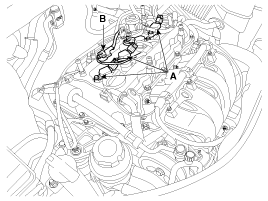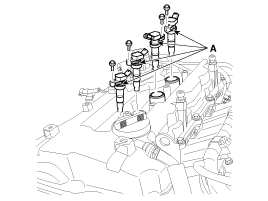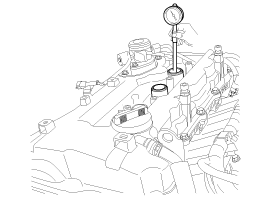 Hyundai Santa Fe: General Information. Repair procedures
Hyundai Santa Fe: General Information. Repair procedures
Compression Pressure Inspection
If the there is lack of power, excessive oil consumption
or poor fuel economy, measure the compression pressure.
|
| 1. |
Warm up and stop engine.
Allow the engine to warm up to normal operating temperature.
|
| 2. |
Disconnect the injector extension connector (A) and
ignition coil connectors (B).
ąóčĆą░ąĮčüą┐ąŠčĆčéąĮą░čÅ ą║ąŠą╝ą┐ą░ąĮąĖčÅ. ąØą░ ą║ąŠčĆą┐ąŠčĆą░čéąĖą▓ ą░čĆąĄąĮą┤ą░ ą░ą▓č鹊ą▒čāčüą░ čü ą▓ąŠą┤ąĖč鹥ą╗ąĄą╝ ąĮą░ 35 ą╝ąĄčüčé ą£ąŠčüą║ą▓ą░ ąĮąĄą┤ąŠčĆąŠą│ąŠ.
|
| 3. |
Remove ignition coils (A).
|
| 4. |
Remove spark plugs.
Using a 16mm plug wrench, remove the 4 spark plugs.
|
| 5. |
Check cylinder compression pressure.
|
| 6. |
Reinstall spark plugs.
|
| 7. |
Install ignition coils.
|
| 8. |
Connect the injector extension connector and ignition
coil connectors.
|
| 9. |
Some DTC's may exist after the inspection test and
may need to be manually cleared with GDS.
|
 Specifications - Revised
Specifications - Revised
Specifications Description Specifications Limit General Type In-line, DOHC Number of cylinders 4 Bore 88 mm (3.464 in) Stroke 97 mm (3.819 in) Total displacement 2359cc ...
 General Information. Troubleshooting
General Information. Troubleshooting
Troubleshooting Symption Suspect area Remedy Engine misfire with abnormal internal lower engine noises. Worn crankshaft bearings Loose or out of specification engine flywheel Replace the crankshaft and ...
See also:
Automatic-dimming function
Your mirror will automatically dim upon detecting glare from the vehicles traveling behind you. The autodimming function can be controlled by pushing the ON/OFF Button: 1. Pressing the button turns the ...
Accelerator Position Sensor (APS). Specifications
Specification Accelerator Position Output Voltage (V) APS1 APS2 C.T 0.7 ~ 0.8 0.275 ~ 0.475 W.O.T 3.8 ~ 4.4 1.75 ~ 2.35 ...
Air Ventilation Seat. Repair procedures
Removal Cushion Blower 1. Remove the front seat assembly. 2. Remove the cushion blower(A) after loosening the screws(4EA) and disconnecting the connector. Back Blower 1. Remove the front seat assembly. ...



